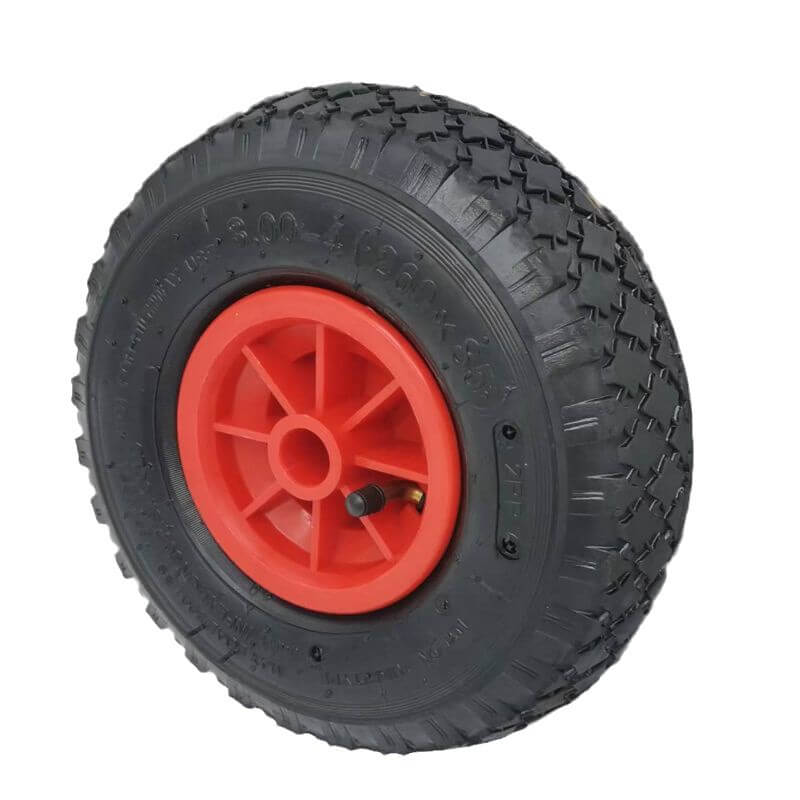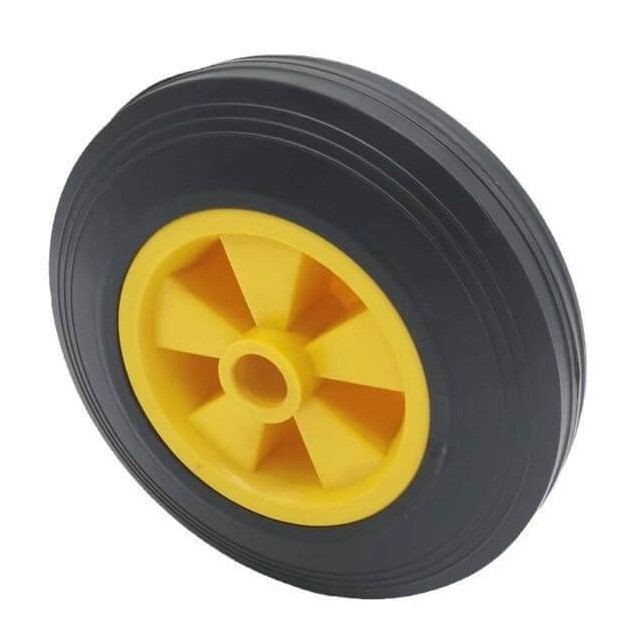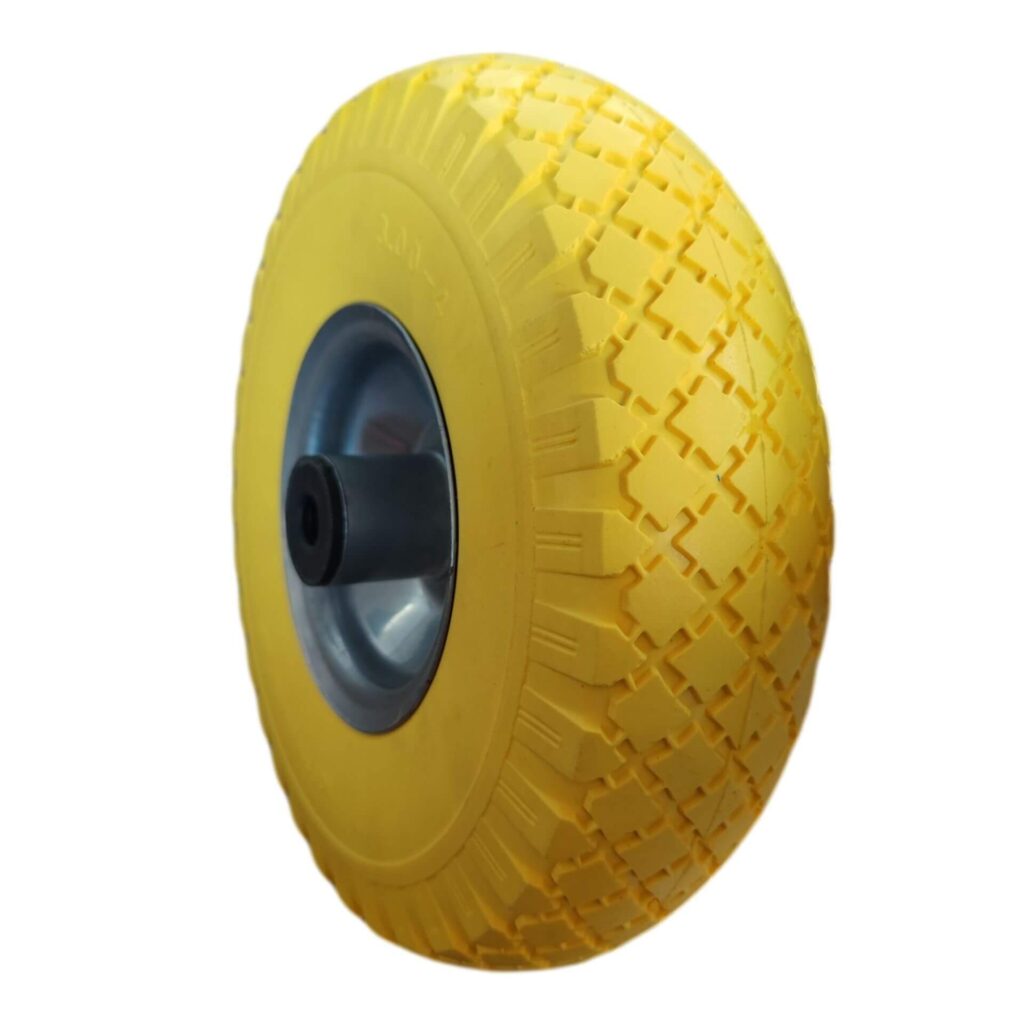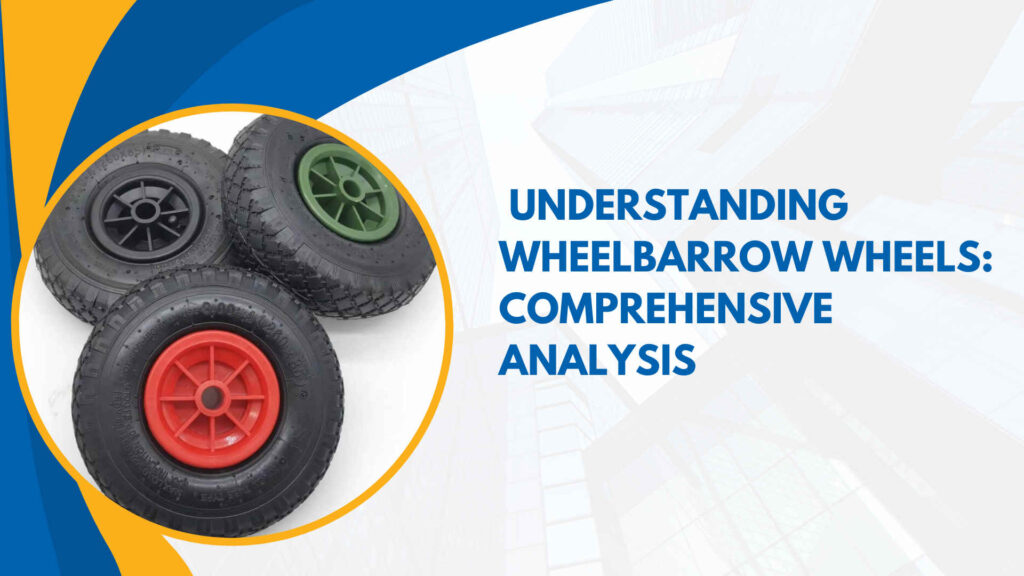1. Introduction
When you’re choosing the best wheel for your wheelbarrow, it’s important to understand the different types of wheels that are available. The wheelbarrow wheel plays a huge role in how well your wheelbarrow performs, especially when it comes to maneuverability, durability, and maintenance. Whether you’re moving dirt, mulch, or other heavy materials, selecting the right wheel will ensure that you get the job done more efficiently and more comfortably. There are three primary wheel types: pneumatic, semi-pneumatic, and solid (foam-filled), each with its own set of strengths and weaknesses. In this article, I’ll help you understand the features of each type and guide you in making the best choice for your needs.
2. What Are Wheelbarrow Wheels?

Wheelbarrow wheels are an important part of the wheelbarrow that supports the load and makes it easy to move. Each wheel is designed to provide specific advantages depending on the tasks you need to complete. The wheelbarrow wheel is the most important part of the wheelbarrow for maneuverability, stability, and efficiency, especially when moving heavy materials. The type of wheel you choose will greatly affect how well your wheelbarrow performs, and understanding how different wheels work will help you make the best decision.
3. Parts of Wheelbarrow Wheels
A wheelbarrow wheel consists of several key parts, each playing a vital role in how the wheel functions. Understanding these components helps in selecting the right wheel for your wheelbarrow and ensuring its smooth performance. Here’s a breakdown of the main parts:
3.1 Inner Tube (For Pneumatic Wheels)

The inner tube is a rubber tube filled with air, which is a key part of pneumatic wheels. This air cushion absorbs shocks and vibrations, making the wheel suitable for rough or uneven surfaces.
- Function: The inner tube provides shock absorption by maintaining air pressure and offering a flexible, cushioned ride over bumpy ground.
- Material: Typically made from durable rubber designed to withstand pressure.
3.2 Wheel Hub
The wheel hub is the central part of the wheel where the axle passes through. It holds the bearings or other mechanisms that allow the wheel to rotate smoothly and attach to the wheelbarrow.
- Function: The hub connects the wheel to the axle, enabling the wheel to rotate freely and smoothly with minimal friction.
- Material: Usually made from strong materials like steel or aluminum for durability.
3.3 Tire (For Pneumatic and Semi-Pneumatic Wheels)
The tire is the outer rubber or synthetic material that touches the ground. For pneumatic wheels, it’s air-filled, while semi-pneumatic tires have air pockets for durability and moderate shock absorption.
- Function: The tire provides traction, helps distribute the weight of the load, and offers stability while the wheelbarrow is in motion.
- Material: Pneumatic tires are made of flexible rubber, while semi-pneumatic tires combine rubber with air pockets.
3.4 Rims (For All Types of Wheels)
The rim is the metal or plastic ring that holds the tire or the inner tube in place. It is essential for maintaining the wheel’s shape and structure.
- Function: The rim ensures that the tire stays securely in place and supports the overall strength of the wheel.
- Material: Typically made from metals like steel or aluminum, though lighter plastic rims can also be used.
3.5 Bearings (For All Types of Wheels)
Bearings are small components that allow the wheel to rotate smoothly on the axle. They minimize friction, ensuring the wheel turns freely and efficiently.
- Function: Bearings enable the wheel to rotate smoothly around the axle with minimal resistance, making the wheelbarrow easier to push.
- Material: Bearings are typically made from metal or ceramic materials designed to reduce friction.
3.6 Axle (For All Types of Wheels)
The axle is the central shaft that the wheel spins around. It connects the wheel to the wheelbarrow’s frame and provides the axis around which the wheel rotates.
- Function: The axle is essential for connecting the wheel to the frame, enabling it to rotate when the wheelbarrow is in use.
- Material: Axles are usually made of strong materials like steel to handle the weight and movement of the wheelbarrow.
4. Types of Wheelbarrow Wheels
4.1 Pneumatic Wheelbarrow Wheels (Air-filled)

4.1.1 What Are Pneumatic Wheels?
Pneumatic wheels are air-filled tires, similar to those found on bicycles or cars. These wheels offer a high level of comfort due to their shock-absorbing qualities. They are perfect for working on uneven terrain, like gravel paths, dirt roads, or grassy areas, because the air inside the tire helps cushion the ride.
4.1.2 How They Work:
Pneumatic tires work by compressing and expanding the air inside as the wheel moves, helping to absorb shocks and vibrations. This gives the user a smoother experience when pushing the wheelbarrow, especially over rough ground. Pneumatic wheels also provide superior traction on soft surfaces.
4.1.3 Advantages of Pneumatic Wheels:
- Excellent Shock Absorption: These wheels are ideal for bumpy, uneven terrain, providing comfort during use.
- Great Traction: Pneumatic tires perform well on soft, loose ground like dirt, gravel, and grass.
- Smooth Ride: The cushioning effect reduces the strain on your arms and hands when pushing heavy loads.
4.1.4 Disadvantages of Pneumatic Wheels:
- Prone to Punctures: The biggest drawback is the risk of punctures. Sharp objects or rough surfaces can damage the tire.
- Regular Maintenance: You’ll need to check the air pressure regularly and repair punctures or leaks when they occur.
- Less Durable: Over time, pneumatic tires may wear out faster than solid options, especially with frequent use.
4.2 Semi-Pneumatic Wheelbarrow Wheels (Hybrid Design)

4.2.1 What Are Semi-Pneumatic Wheels?
Semi-pneumatic wheels are designed with a solid rubber outer layer and air pockets inside, offering a middle ground between pneumatic and solid wheels. While they do provide some shock absorption, they are more durable than pneumatic wheels and don’t require as much maintenance.
4.2.2 How They Work:
The air pockets inside semi-pneumatic tires absorb some of the shock when moving over rough terrain, but the solid rubber exterior prevents punctures. This makes them a good choice for environments that mix smooth and slightly uneven ground.
4.2.3 Advantages of Semi-Pneumatic Wheels:
- Puncture-resistant: Unlike pneumatic tires, semi-pneumatic wheels do not lose air, reducing the chance of punctures.
- Longer Lifespan: These wheels tend to last longer than pneumatic tires, as they are less prone to damage from sharp objects.
- Moderate Shock Absorption: While not as cushioned as pneumatic wheels, they still provide some comfort when working on moderately rough ground.
4.2.4 Disadvantages of Semi-Pneumatic Wheels:
- Less Cushioned Ride: They don’t provide the same level of shock absorption as pneumatic wheels, so they may not be ideal for very rough terrain.
- Limited Performance on Rocky Terrain: If you frequently work on very rocky or uneven ground, they may not offer the same comfort as fully pneumatic tires.
4.3 Solid Wheelbarrow Wheels (Foam-filled)

Solid wheelbarrow wheels, often foam-filled, are made from materials like durable rubber, polyurethane, or foam that provide flat-free performance. These wheels are designed to withstand heavy use without the risk of punctures or deflation, offering a maintenance-free experience. While they don’t have the shock absorption properties of pneumatic wheels, foam-filled solid wheels are a reliable, low-maintenance option, especially for flat, smooth surfaces.
4.3.1 Advantages of Foam-filled Solid Wheelbarrow Wheels:
- Flat-Free: Made from durable materials like foam or rubber, these wheels cannot get flat or punctured, ensuring constant readiness.
- Low Maintenance: No need for air pressure adjustments or repairs, making these wheels the perfect choice for users who want hassle-free performance.
- Durability: Foam-filled wheels are highly resistant to wear and tear, making them ideal for long-term, heavy-duty use.
- Stability: These wheels offer excellent stability and are less prone to wobbling, even under heavy loads.
4.3.2 Disadvantages of Foam-filled Solid Wheelbarrow Wheels:
- Less Shock Absorption: Foam-filled wheels are not as cushioned as pneumatic or semi-pneumatic wheels, so the ride can be bumpier when navigating rough or uneven terrain.
- Heavier: Solid foam-filled wheels are often heavier than air-filled options, which can make the wheelbarrow harder to maneuver when fully loaded.
5. Comparison of Pneumatic Wheels, Semi-Pneumatic Wheels, and Solid Wheelbarrow Wheels
| Feature | Pneumatic Wheels | Semi-Pneumatic Wheels | Solid Foam-filled Wheels |
|---|---|---|---|
| Shock Absorption | Excellent | Moderate | Low |
| Puncture Resistance | Moderate | High | Very High |
| Maintenance | High | Low | Very Low |
| Traction | High (on soft surfaces) | Moderate (good balance) | High (on hard surfaces) |
| Durability | Moderate | High | Very High |
| Comfort | Very High | Moderate | Low |
| Weight | Light | Moderate | Heavy |
| Budget | Low (but ongoing maintenance) | Moderate | High (but minimal maintenance costs) |
6. Factors to Consider When Choosing a Wheelbarrow Wheel
6.1 Terrain
Consider the terrain you’ll be working on most often. For rough or uneven ground, pneumatic wheels are the best option for comfort and performance. If you mainly work on flat, smooth surfaces, solid foam-filled wheels could be ideal.
6.2 Load Capacity
Different wheels are designed for different load capacities. Pneumatic and semi-pneumatic wheels are typically suitable for medium loads, while solid wheels can carry heavier loads without compromising stability.
6.3 Maintenance
Pneumatic wheels require regular air checks and are prone to punctures, making them higher maintenance. Semi-pneumatic wheels offer a good balance, needing less maintenance with their air-filled design. Solid wheels require almost no upkeep—no air pressure to check and no risk of flats, but they don’t provide the same level of comfort.
6.4 Budget
Pneumatic wheels are generally the least expensive upfront, but maintenance costs over time can add up. Semi-pneumatic wheels are a bit more costly but provide a durable, low-maintenance option. Solid wheels may have a higher initial price but are more cost-effective in the long run due to their durability and minimal upkeep.
6.5 Wheel Diameter and Hub Bore
Don’t forget to check the wheel diameter and hub bore size. Larger wheels are better for rough terrain as they roll over obstacles more easily, while smaller wheels are more agile on flat surfaces. The hub bore must match the axle size of your wheelbarrow for a secure fit.
7. Common Wheelbarrow Wheel Problems and How to Fix Them
Even the best wheelbarrow wheels can face issues over time, particularly with regular use. Here are some common problems you might encounter with your wheelbarrow wheels, along with solutions for each:
7.1 Flat or Punctured Pneumatic Wheelbarrow Wheels
One of the most common issues with pneumatic wheels is flats due to punctures. Fortunately, these are relatively easy to fix.
How to Fix It:
- Remove the wheel from the wheelbarrow.
- Use a tire patch kit to cover the puncture or replace the inner tube if the hole is too large.
- Reinflate the tire to the recommended pressure and reattach the wheel.
7.2 Low Air Pressure in Pneumatic or Semi-Pneumatic Wheelbarrow Wheels
Sometimes, pneumatic or semi-pneumatic tires lose air over time. Regular checks can prevent this problem from hindering performance.
How to Fix It:
- Check the tire pressure with a gauge.
- If the air pressure is low, inflate the tire using a standard air pump until it reaches the correct pressure level, as recommended by the manufacturer.
7.3 Wear and Tear on Solid Wheelbarrow Wheels
Solid wheels, though durable, can wear down over time, especially if used on rough surfaces.
How to Fix It:
- Inspect the solid wheels for cracks or tears.
- If the wheel has excessive wear, consider replacing it entirely as solid wheels cannot be repaired like pneumatic tires.
7.4 Wheel Wobbling or Uneven Rotation
If your wheel starts wobbling or doesn’t rotate smoothly, it could be a sign that the bearings or the hub are damaged.
How to Fix It:
- Check the bearings to ensure they are not damaged or loose.
- If the bearings are worn, replace them with new ones. If the hub is damaged, it may need to be replaced as well.
8. Tips for Maintaining Wheelbarrow Wheels
To keep your wheelbarrow wheels in top condition and extend their lifespan, regular maintenance is key. Here are a few tips to help you get the most out of your wheelbarrow wheels:
8.1 Check the Pressure Regularly (For Pneumatic & Semi-Pneumatic Wheels)
Maintaining the right tire pressure ensures optimal performance. Pneumatic and semi-pneumatic wheels should be checked regularly to avoid deflation and ensure maximum efficiency when transporting loads.
8.2 Clean Your Wheels After Each Use
Dirt and debris can accumulate around the wheels, causing damage over time. After each use, make sure to clean the wheels thoroughly with water and a mild detergent.
8.3 Store in a Dry Place
When not in use, store your wheelbarrow in a dry, cool place to avoid premature wear, especially on pneumatic wheels, which can degrade in direct sunlight.
8.4 Lubricate the Bearings
To maintain smooth rotation and prevent rusting, it’s a good idea to lubricate the bearings periodically. This will keep the wheelbarrow functioning smoothly for years to come.
8.5 Inspect for Cracks or Damage
Especially for solid wheels, check for cracks or signs of damage that could affect performance. If you find any, replace the wheel promptly to avoid accidents.
9. Conclusion
Choosing the right wheelbarrow wheel is important if you want to make your tasks easier and more efficient. Pneumatic wheels are great for rough terrain, semi-pneumatic wheels are a good balance between comfort and durability, and solid wheels require little maintenance and are durable on flat, hard surfaces. By understanding the different types of wheels and considering your specific needs, you can choose the best wheelbarrow wheel for your work environment. Taking care of your wheelbarrow and performing regular maintenance will help it last longer and perform better, making your projects easier to complete.
For more questions or needs, reach us at:
Email: info@techincastor.com
Tel/WhatsApp: +86 13417057114






